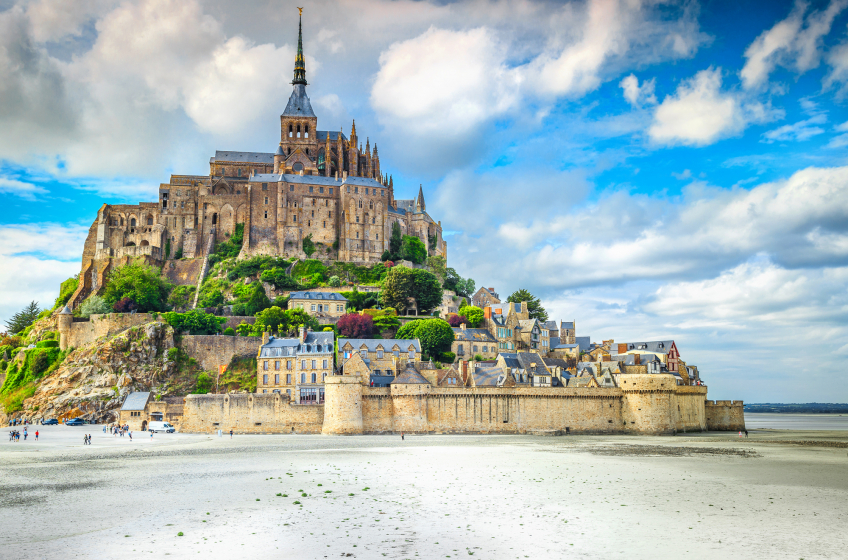Discover Mont-Saint-Michel | A Visitor's Introduction to Mont-Saint-Michel
Mont-Saint-Michel, one of France’s most iconic landmarks, is a mesmerising island commune situated off the coast of Normandy. Known for its dramatic setting and stunning medieval architecture, this UNESCO World Heritage site attracts millions of visitors each year.
Recommended Mont-Saint-Michel Accommodation: Hotels Bed & Breakfasts
Historic and Architectural Highlights
Mont-Saint-Michel’s history dates back to the 8th century when the Bishop of Avranches, Aubert, founded a sanctuary on the island following a vision of the Archangel Michael. The centrepiece of Mont-Saint-Michel is the Abbey of Mont-Saint-Michel, a breathtaking example of medieval architecture perched atop the rocky island. The abbey complex includes Gothic and Romanesque elements, with highlights such as the Merveille (the Marvel), a series of stunning monastic buildings, and the abbey church, which offers panoramic views of the surrounding bay.
The island’s narrow, winding streets are lined with historic buildings, shops, cafes, and museums, creating a unique medieval atmosphere. La Grande Rue is the main street, leading visitors from the base of the island to the abbey at the summit. Along the way, you’ll encounter charming boutiques, popular restaurants, and interesting museums such as the Mont-Saint-Michel Historical Museum and the Maritime Museum.
The Bay of Mont-Saint-Michel
The bay surrounding Mont-Saint-Michel is known for its extreme tides, which can vary by up to 15 metres between high and low tide. During high tide, Mont-Saint-Michel is completely surrounded by water, creating a striking image of an island fortress. At low tide, a vast expanse of sand and mudflats is revealed, allowing visitors to walk around the island.
Guided walks across the bay are a popular activity, providing an opportunity to explore the unique tidal environment and learn about the local ecology and history. It’s important to only undertake these walks with a knowledgeable guide due to the dangers of quicksand and rapidly rising tides.
Pilgrimage and Spiritual Significance
Mont-Saint-Michel has been a major pilgrimage site for centuries, drawing visitors from around the world seeking spiritual solace and inspiration. The abbey’s serene atmosphere and awe-inspiring architecture provide a perfect setting for reflection and contemplation. Religious services are still held in the abbey, and visitors are welcome to attend.
Culinary Delights
The culinary scene on Mont-Saint-Michel is rich with regional specialties. La Mère Poulard is one of the most famous establishments, renowned for its fluffy omelettes cooked over an open fire. This restaurant, founded in 1888, has hosted numerous celebrities and dignitaries over the years.
Seafood is also a highlight, with local delicacies such as mussels and oysters being particularly popular. Le Relais du Roy and Le Mouton Blanc are other notable dining options, offering traditional Norman cuisine with views of the bay.
Festivals and Events
Mont-Saint-Michel hosts a variety of cultural and religious events throughout the year. The Archangel Michael’s Day on September 29th is a significant celebration, featuring religious ceremonies, processions, and festivities. The Mont-Saint-Michel Marathon, held annually, attracts runners from around the world who come to compete in this unique and challenging race.
Practical Tips
Mont-Saint-Michel is accessible by road, with parking available on the mainland about 2.5 kilometers from the island. From there, a free shuttle service (Passeur) or a picturesque 45-minute walk across the causeway takes you to the island. For a more unique experience, consider arriving during low tide on foot or by horse-drawn carriage.
Accommodation options range from charming inns and hotels on the island, such as Auberge Saint-Pierre and La Vieille Auberge, to a variety of options on the mainland. Staying on the island allows you to experience the magical atmosphere after the day-trippers have left, but mainland accommodations often offer more amenities and easier access.
When planning your visit, check the tidal schedules to ensure you can fully appreciate the dramatic changes in the landscape. The best times to visit are during spring and autumn when the weather is mild, and the crowds are smaller.
Shortlist
- Your Shortlist is empty

